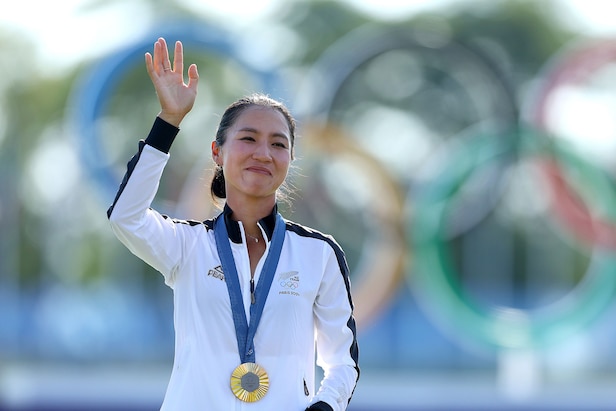How a popular social-media stats guru has become a critical part of the U.S. Solheim Cup team – Australian Golf Digest

- by Admin
- September 10, 2024

The analytics era for the U.S. Solheim Cup team didn’t get off to the smoothest start. Captain Stacy Lewis hired KPMG Performance Insights lead analyst Justin Ray to serve the American team for the 2023 competition against Europe, and then with 25 potential players and captains in a room waiting for a presentation, a flustered Ray struggled to connect the cord from his computer to the projection system. Assistant captain Morgan Pressel ended up coming to the rescue.
Back on track, Ray delivered an energizing 15-minute presentation that kept the entire room rapt with attention, launching the American program’s evolution that continues this week with the U.S. hosting the Solheim Cup outside of Washington, D.C.
In Lewis’ judgment, no longer would the U.S. figure out pairings based on the old-guard belief that whichever team simply putts best wins the Solheim Cup. Now, the American team would attempt a form of “Moneyball” to maximize its chances of winning by sorting through a trove of statistics to develop its roster and session lineups. The work in 2023 ultimately didn’t result in a victory—the teams tied 14-14 and Europe retained the Cup—but Lewis was convinced she found a promising path forward.
“Once I start talking about the stuff I do every day, it’s like riding a bike,” Ray said. “I’ve got it all right there. It’s just fun to get into the weeds and to have an engaged captain and engaged team want to know more and ask questions, and really be intrigued by it when they fully could have just been staring at their cellphones and not listening to me. I would have totally understood, but they were really engaged.”
Ray’s emergence in the LPGA world began by being hired in 2019 by Twenty First Group, a data-driven sports intelligence company, as the head of content. Ray started covering golf as a senior researcher for ESPN and Golf Channel after graduating from Missouri Journalism School in 2007 before joining the statistics firm.
His work at Twenty First Group including creating a caddie-driven system on the DP World Tour for tracking every shot to generate strokes-gained statistics. That project led the LPGA to approach Ray in 2021 and ask for a similar system for its tour. That generated the beginning of the KPMG Performance Insights program, which also used caddies to track statistics. Ray, 39, and his team combed through the data to identify minor tweaks that better fit the women’s game before its unveiling later that year.
More From Golf Digest Solheim Cup What’s on the line at the Solheim Cup? Analyzing what feels like a ‘must’ win for the Americans  Course Strategy 3 holes that could decide the Solheim Cup
Course Strategy 3 holes that could decide the Solheim Cup 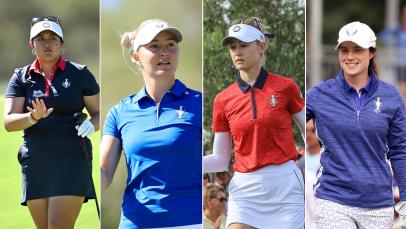 Solheim Cup All 24 players competing in the 2024 Solheim Cup, ranked
Solheim Cup All 24 players competing in the 2024 Solheim Cup, ranked
When Lewis was announced as the American captain in 2022, her early thoughts on how she wanted to lead the team included making changes to how the team picked its pairings. In the past, the American program didn’t worry much about anything, considering its 8-3 overall record in the event’s first 11 matchups. The Euros started catching up in 2011 and won four of the six Solheim Cups before Lewis became captain. Alarm bells started going off.
The first attempt by a U.S. captain to utilize some data for pairings came from Juli Inkster in 2015, when she incorporated personality tests into figuring out who would play well together. It served only as a loose outline, as Lewis recalled going back and forth with Inkster that year on whether she and Gerina Piller should play foursomes together.
Following the team’s philosophy, Inkster argued that Piller was not a good enough putter to send out in the format. Lewis pushed back and said they would be fine as they could read putts together. The pair then won 5 and 4. Lewis realized that their quality ball-striking, more than their putting, led to their outsized victory.
“It kind of just opened my eyes to, like, maybe we haven’t always done things right in the past,” Lewis said. “Frankly, we hadn’t, just given the way things had been going.”
Ray first met Lewis near his Texas home at the Ascendant LPGA in 2022. He became part of a captain’s group chat, with Ray sending various statistics of trends that popped up throughout the year. Ray answered Lewis’ varying inquiries like an on-call doctor. One random evening, she asked him to make a list of who was making the most birdies per round on the team. He responded within 10 minutes.
Starting to get the team to buy into the analytics-oriented approach came during that first presentation, at the 2023 Founders Cup, and there were early interactions with players who showed plenty of interest. A prominent multiple-time winner asked Ray how the win percentages would change based on who would tee off on odd or even holes in foursomes. Two-time Solheim Cup veteran Ally Ewing picked his brain for 45 minutes on varying stats. Allisen Corpuz made the statistical analyst feel old when she mentioned she had followed him on Twitter since the then-25-year-old was a kid. She was enthralled by the presentation, having run a similar 10,000-simulation probability model as part of her Global Supply Chain Management master’s program at USC.
“It was just really eye-opening to see how much data they had collected and gone through,” Corpuz said.
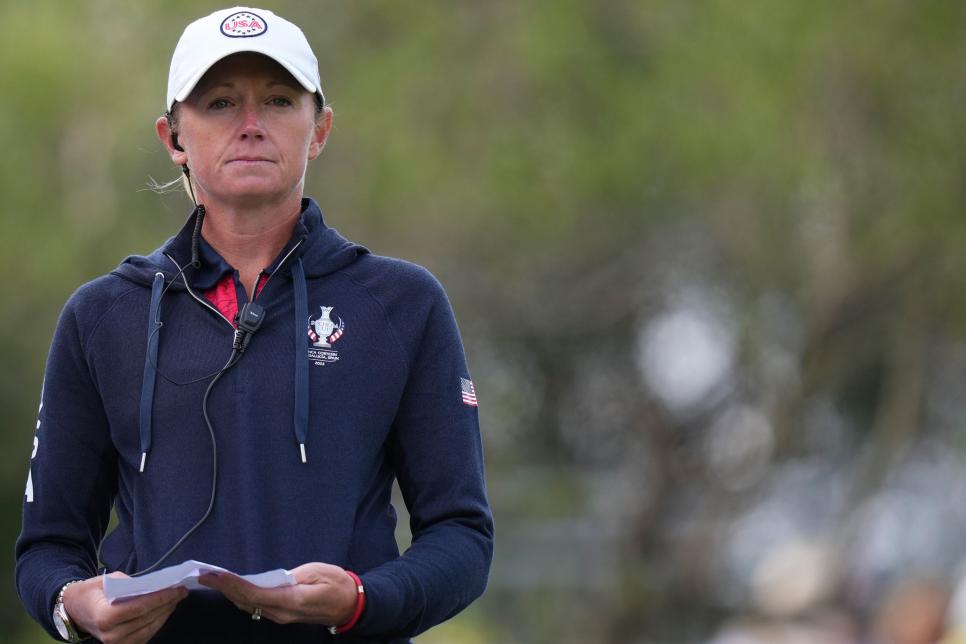
An experience from playing in the 2015 Solheim Cup helped Stacy Lewis vow that when she took over as captain, she would be better prepare with data to help make better decisions.
Angel Martinez
Ray only met with the players on the team in person one more time between then and the Solheim Cup in Spain. His five-person team created an internal app to make all their info available to the captains in real time. They had win probabilities for any potential pairings against what the system deemed the best possible Euro combo, with green lights given a more likely chance at victory and red a likely loss.
“The word analytics is just kind of a buzzword in sports at this point,” Ray said. “But really all you’re doing is you’re just taking strategy and giving it an empirical backbone.”
The analytics team was so invested in its Solheim Cup work it created a strokes-gained system for practice rounds in Spain. In contrast to Allen Iverson’s classic line “We’re talking about practice,” the practice stats ultimately pointed to a couple of needed lineup changes before play started in Spain.
The system flagged that the beleaguered Lexi Thompson was in stellar form even though she had missed five of six cuts heading into the Solheim. “It’s one thing to just have watched her hit a bunch of drives down the middle and like that she’s playing well,” Pressel said. “But it’s another thing to have those numbers that say, wow, she, she really is [playing well].”
Armed with the data, Lewis deviated from her initial plan and asked Thompson, practicing with Megan Khang, to figure out a ball they could use for foursomes. Three holes later, they told their leader they were ready to go.
“I did not sleep on Thursday night,” Lewis said. “Like, I was just, was this the right move? Did we dive too much into the stats? Am I trusting this too much?”
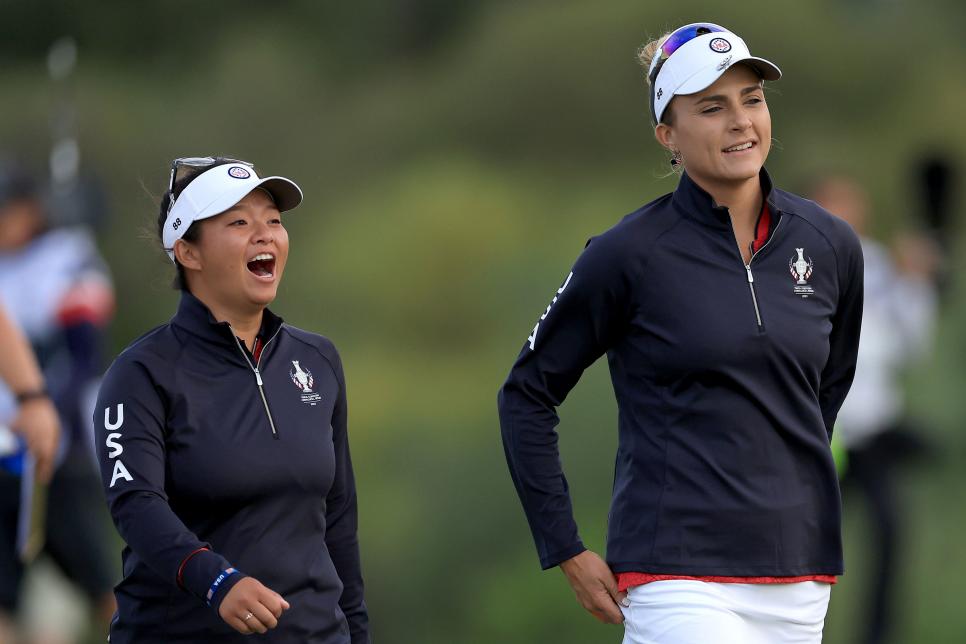
The pairing of Megan Khang and Lexi Thompson at the 2023 Solheim Cup was a late change by U.S. captain Stacy Lewis on advice from Ray.
David Cannon
When the opening pairings were announced, Ray checked Twitter and saw the chatter decrying “what are they doing” about the decision to play Thompson. He understood why those outside the team room would question the decision, but on Friday morning they were vindicated. Thompson and Khang jumped to a 3-up lead through three holes and won 2 and 1, starting a 4-0 American foursomes sweep for the first time in Solheim history. The emphatic start confirmed that what they were doing made sense.
“For us, for it to go out and be validated … I’d be lying if I said that didn’t have an impact on the way we were seen within the team room,” Ray said.
“To put that session up,” Lewis said, “was just total validation of all the work that we had put in and, like, we’re doing this right.”
Ray worked to ensure his team was more than just people in the corner hiding behind computers. During meals, his effusive personality permeated through the group, with a fired-up attitude bringing positivity to the players he spent time with over meals. His ever-analytical mind realized that he wanted to leave a positive effect if his interaction might impact an outcome.

Lewis is using Ray’s data to also help answer course set-up questions at Robert Trent Jones Golf Club that can play to American team’s strengths.
His final mark in Spain fittingly came on Sunday singles alongside Thompson. With the order of the final matches determined and Ray’s job mostly finished, Lewis needed one more person on radio to keep the captains updated on how various players were doing. He became the volunteer, following Thompson for her 2-and-1 win to finish off a 3-1-0 week—her best Solheim Cup since 2017.
“He’s so positive and just always trying to find more points for us,” Lewis said. “He was devastated that he couldn’t find us a half a point last year.”
Spain was a launch point for what the analytics could do. Learning from last year, Lewis felt her team needed to find better four-ball players for this year at Robert Trent Jones Golf Club because the Euros went 6-2 in the format in Spain. Ray visited the 2024 venue earlier in the year, incorporating data from the PGA Tour’s 2015 Quicken Loans National event to generate profiles of the players who succeeded on the course.
With Ray’s assessment of the U.S. and European teams and their comparative advantages, the data pointed out to Lewis that her team’s on-paper edge was in ball-striking. While captains don’t have as much say in course setup in the Solheim Cup as in the Ryder Cup, Lewis says she had more input this year than any other in the event’s history. The captain encouraged setting the course up to keep fairway bunkers in play off the tee instead of a shorter layout to capitalize on the team’s strong suit.
“I didn’t want the officials to start moving up a bunch of tees and put wedges in people’s hands, because that’s not the game we’re going to win,” Lewis said. “We’re going to win if we’ve got to hit some 5-irons, some 7-irons, hit a fairway, hit a green. That’s more the contest I want to create for our team.”
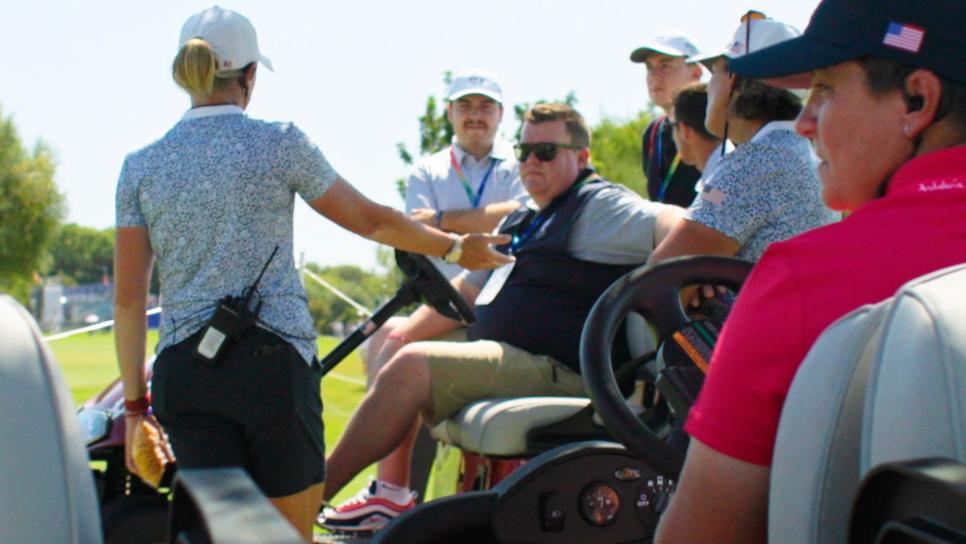
Frustrated he couldn’t help the U.S. team grab a last half point to win in 2023, Ray has gone all in on helping the Americans claim victory in 2024.
Ray hopes to continue being part of the Solheim Cup because he loves the event’s camaraderie. He’s enmeshed with the team, even ordering a custom U.S. Olympic basketball jersey to wear at the matches. “Korda” is the name on the back, and Ray picked No. 5 for her five straight wins this year to wear during the Cup.
The only reason Lewis envisions the relationship ending is cost, which will be an expense for the next American captain to sort through. Ray believes his most significant impact on the overall American program has been providing the infrastructure for new ways to identify the best way to build a roster and produce more consistent good results. He ended an interview, however, hoping to provide a different answer in short order:
“It’s that we’ve won the Solheim Cup.”
This article was originally published on golfdigest.com
The Latest News
-
January 1, 2025‘I Love Virat Kohli’: PM Anthony Albanese on Australia India Cricket Rivalry
-
January 1, 2025Elena Rybakina rehires coach Stefano Vukov for 2025 season in shock move before Australian Open
-
January 1, 2025The Sentry picks 2025: Our caddie’s Ryder Cup-inspired best bet – Australian Golf Digest
-
January 1, 20252025 The Sentry tee times, TV coverage, viewer’s guide – Australian Golf Digest
-
January 1, 2025Bethpage Ryder Cup, Masters course comeback and new women’s major sites highlight 2025’s must-see golf – Australian Golf Digest





